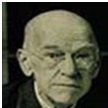|
 |
|
 |
|
|
||
Elton Mayo (1880-1949)
Australian professor at Harvard Business School (pictured right) and founder of the Human Relations Movement which believes that employees are motivated by satisfying their needs. Mayo is most famous for his research study of workers at the Hawthorne factory of the Western Electrical Company in Chicago from 1927 to 1932 (known as the Hawthorne Experiment) which emphasized the importance of informal work groups.
Key book
The Human Problems of an Industrial Civilization (1933) This book explains what happened in the Hawthorne Experiment (see above) This occurred in two stages:
1st Stage - The Relay Assembly Test Room This involved six female assembly line workers. Improvements in their pay and working conditions (e.g. rest pauses and shorter hours) increased their productivity. Then these improvements were removed, and productivity continued to rise! So Mayo concluded that the women were motivated by other factors:
2nd Stage - The Bank Wiring Observation Room This involved a group of male workers who
An organization must reconcile the different interests of:
This reconciliation will improve relations between them and increase employee motivation.
Key quote on management The desire to stand well with one's fellows...easily outweighs the merely individual interest. |
|
|
||
|
|
||
| Copyright © wisdomtowin.com 2025 All Rights Reserved | ||
|



